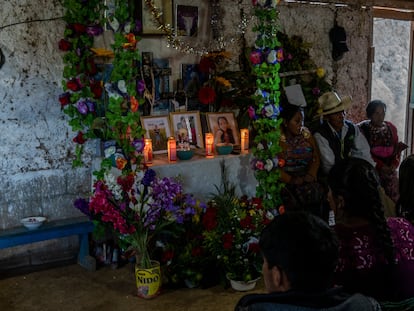El Mozote: 40 years after the worst military massacre in the Americas, victims still calling for justice
Despite decades of institutional silence, a judge continues to fight to bring to trial those responsible for killing nearly 1,000 peasants in El Salvador in December 1981
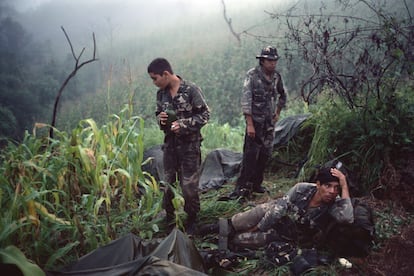

The day they arrived, the troops promised to deliver food supplies to this desperately poor region of El Salvador. Instead, they gathered the villagers onto an area of a wasteland and massacred them. Between December 10 and 12, 1981, the screams mixed with the howls of dogs near El Mozote.
Amadeo Martínez Sánchez, 49, lost 25 family members. His mother and three siblings aged one, five and seven, were among those who had their lives cut short at the hands of soldiers from the Atlácatl battalion of the Salvadoran army, many of whom had trained at the notorious School of the Americas (some of whose graduates were also involved in another high-profile killing in El Salvador, the assassination of six Jesuit priests in 1989). “When we were able to get close we saw that the pigs were eating the corpses, the chickens were pecking at them, so we put the remains in hammocks and blankets and buried them all in a pit,” recalls Martínez.
Of all the horrors that El Salvador has suffered, the El Mozote massacre is perhaps the most terrible of all: at least 986 people were killed (552 children and 434 adults, including 12 pregnant women) in three days of bloodletting. Forty years have passed and neither Martínez nor the rest of the survivors have received justice or reparations. “We are very disappointed,” he says, resurfacing memories of his nine-year-old self witnessing the worst massacre ever recorded in the Western Hemisphere.
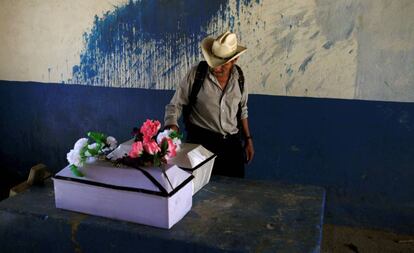
Amadeo Martínez was preparing to attend a mass organized as a tribute to the victims, along with his neighbors. The mass is held yearly in La Joya, a hamlet set across the gentle mountains of the eastern part of El Salvador, where there is a humble shrine made from sticks and corrugated iron sheets. “Nobody wanted to help us,” he remembers. In order to erect the monument for the victims, he had to donate the land himself.
On December 9, 1981, his father José Santos Sánchez arrived at home looking upset. He said he had heard rumors that the military would soon deploy to the area, and urged his wife María Inés Martínez to leave the house. El Salvador was bleeding out from a civil war between the Army and the Farabundo Martí National Liberation Front (FMLN) guerrillas that would ultimately leave at least 75,000 victims. The military had orders to wipe out alleged “communists” trying to seize power in the country, and peasants were among the main targets. Many were accused of providing protection to the insurgency, which had a strong presence in the area.
Amadeo Martínez’s family left their home in La Joya and went to another nearby hamlet. A neighbor, Jacinto Sánchez, gave them shelter, but on the condition that only Amadeo’s parents and younger siblings would sleep in his house. He and his older brother had to stay outside. In the early hours of December 10 they tried to move on again, but his mother objected: she wanted to return home, claiming that they had nothing to hide. She stayed behind with her younger children, while the older siblings and the father went into hiding.
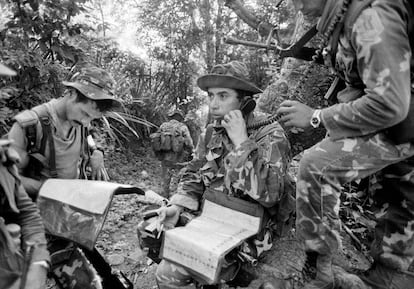
Martínez remembers vividly what happened next. “On December 11, the military passed through La Joya. It was Domingo Monterrosa’s army, the Atlácatl battalion. We heard the dogs barking and we got worried. There were soldiers everywhere, a lot of commotion. At 2pm they brought out the people who were in Jacinto’s house. There were eight children who had taken refuge there. We saw them being dragged away, screaming. One of them was screaming that his mother was in the house and a military commander signaled two soldiers to go inside. There was a lady in bed who had given birth to a girl. She was Jacinto’s daughter-in-law. We heard the shot when she was killed. Three or four days later we came out from where we were hiding and passed by the house. She was lying dead in her bed and the baby girl had a knife buried in her throat. With the blood they had written on the walls of the room: “One child dead, one guerrilla less.” She was a little angel. We don’t understand why they did it,” says Martínez.
“Why?” is the question that the survivors of El Mozote, La Joya and Los Toriles, villages located in the north of the Morazán administrative department, have been asking themselves for 40 years. Alma Guillermoprieto was one of the first reporters to reach the region and chronicled what she saw in a story for The Washington Post on January 27, 1982. “Reporters taken to tour the region and speak to the survivors by guerrilla soldiers, who control large areas of Morazan Province, were shown the rubble of scores of adobe houses they and the survivors said were destroyed by the troops in the now deserted village community. Dozens of decomposing bodies still were seen beneath the rubble and lying in nearby fields, despite the month that has passed since the incident,” she wrote. Following the publication of Guillermoprieto’s account, the US government denied the veracity of the story and said there was a “plan” to discredit the Salvadoran armed forces.
Fidel Pérez Pérez is 46 years old, and he tells a similarly heartbreaking story. He recalls that when the military arrived, his land was razed to the ground and he and his family, along with dozens of neighbors, ran for their lives. The elders, who knew the terrain well, led their flight. About 60 of them spent three days without food, drink or sleep, and were soaked by the rain. The elders decided to return to their hamlet in the early morning of December 11. “At 4am they shot at us. The moon was clear and was a witness to what happened to us. The people fled, they dispersed. My dad and my mom grabbed me and my siblings by the hand. My mom was carrying my three-day-old baby sister. We ran and ran until it was clear. We arrived at a place known as Cerro Ortiz. We stopped there at about 9am and soon there were about 20 of us,” he says.

They were close to a cave that offered some protection. Fidel recounts how a woman decided to go down to a nearby river to wash her children’s clothes when the military saw her. “She came running back and told us: ‘Today they will kill us.’ We began to pray. Then a soldier appeared, he was short with a blotchy face. He said nothing. He took a grenade from his chest and threw it in the cave. It was 11am.” The blast lifted them off their feet, and Fidel, his father and two brothers lost consciousness. “We didn’t know if we were asleep or dead. We woke up at 6pm. My father was talking to us. I had wounds on my forehead and arms and my younger brother had burst eardrums. My dad couldn’t hear, either. The dead were on top of us, we were emerging from a pile of the dead,” he recalls. Twelve people died that morning, among them Fidel’s mother and his newborn sister. The survivors fled again, and eight days later they returned to the place to bury the bodies, which were decomposing.
In 1991, those who survived the massacre returned to the areas razed by the military and found the ruins of what had been their homes. They had to start their lives from scratch, without any support. The remains of Fidel’s mother and sister were exhumed in 2019 for DNA testing, but to date the tests have not been performed and the remains have not been delivered to the family, the farmer says. “We want to give them a Christian burial,” he laments. “We demand justice, and we want to know the truth, so that these events are not repeated,” he says. “It wasn’t our fault that we got caught between two sides that were fighting. These are open wounds. We are going to die and we will never forget. We will always carry them in our hearts.”
With the peace accords signed in Central America and the establishment of democracy, successive governments in El Salvador have denied the massacre. But the prestigious Argentine Forensic Anthropology Team has worked in the area, and in 1993 it corroborated the reports about the massacre. An amnesty law passed that year further kept a lid on the case, although the victims did not let up in their efforts to find justice. They have organized themselves, sought support from human rights institutions, and with time the case reached the Inter-American Court of Human Rights, based in Costa Rica. On October 25, 2012, the court recognized the state’s responsibility for the human rights violations perpetrated by the Salvadoran army in El Mozote. Despite this, none of those responsible have been tried for the crimes committed. The victims saw a glimmer of hope in July 2016, when the Salvadoran Court declared the amnesty law unconstitutional, and Judge Jorge Guzmán then reopened the case and led its proceedings.
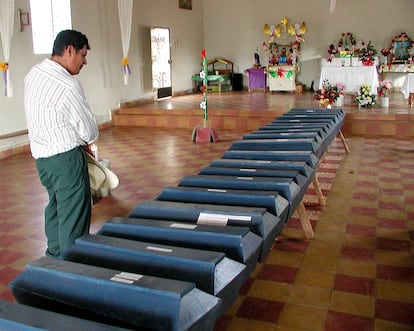
The arrival of President Nayib Bukele brought hope, as he spoke out against the corruption and impunity of previous governments. After assuming the presidency in early June 2019, Bukele’s first order as president was to remove from a military barracks the name of Lieutenant Domingo Monterrosa, whom the United Nations Truth Commission (created to investigate the civil war) said was responsible for the massacre.
The victims’ joy was short-lived, however, as Bukele began centralizing his own power. The Legislative Assembly, which is controlled by the ruling party, approved a decree that forces judges over 60 years of age or with 30 years of service to resign. Judge Guzmán was removed from the case. Then, in October last year, Bukele unleashed a new political crisis in El Salvador by preventing the release of military archives related to the massacre. Both the government and the armed forces disobeyed a court order issued by the judge allowing for the inspection of the archives as part of the judicial process.“
”Since I left, the case has been on hold,” says Guzmán in a telephone interview. “I believe the new judge has not done anything because it is a gigantic case that has to be studied, soaked in,” he explains. He himself struggled to move the process forward. “In a society as polarized as ours it is difficult. The military side did not look favorably on the reopening of the case, and they said that the wounds of the past should not be reopened, because that prevents national reconciliation and the advancement of democracy. Some on the left expressed lukewarm sympathy, but it was simulated, hypocritical. Neither the military nor the FMLN are interested in an investigation, because both have open cases of human rights violations during the armed conflict and they are protecting each other. This case has advanced only under international pressure, with the victims and with the support of the Inter-American Court.”
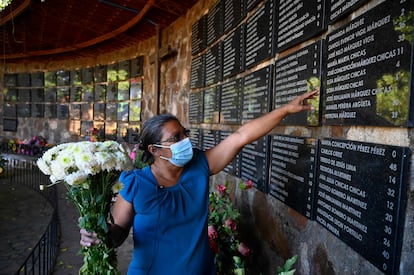
There are at least 17 retired military personnel accused of involvement in the massacre. Two of them were part of the Joint Chiefs of Staff of the army, Guzmán says. There are others who headed important military units, and officers who directed the operation. Among the group of military officers implicated is the Minister of Defense, José Guillermo Garcia, who was convicted in the United States and deported to El Salvador.
Why does Bukele protect the military? “The rulers in our countries need to be in good standing with the army to stay in power,” suggests Guzmán. “There is a pact: the military gives him stability and he supports them by not allowing these gentlemen to face trial,” he says. The judge is harsh in his criticism of the president. “He is handling the case politically. Bukele has made a mockery of the good faith of the victims, of their yearning for justice. President Bukele, like previous governments, is giving continuity to the policy of cover-up for perpetrators of human rights violations during the conflict. This policy only perpetuates impunity.”
Amadeo Martínez Sánchez also has choice words for the president, proclaiming himself “very disappointed” by Bukele’s actions. “When he took office, he said he was going to open the military archives. He even welcomed a delegation of victims to the presidential palace, where he promised to bring justice. Now he claims that he had nothing to do with it, because he was a child when it happened. That hurt us, because it is disrespectful. We deserve respect and justice,” he says. Despite the political tide turning against them, neither the victims nor their supporters will relent.
“There is no backsliding,” says Judge Guzmán. “It has already moved ahead by 85% and only a little is left. This process has to come to an end, whether or not I will be around to see it.”
More information
